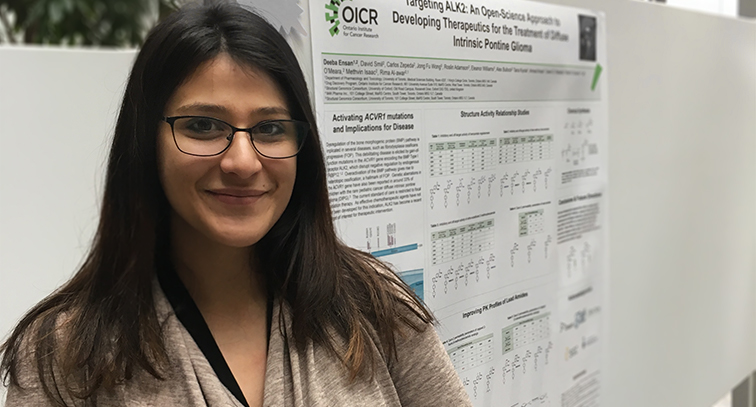An open-science brain cancer drug development initiative makes for a memorable master’s experience

Diffuse intrinsic pontine glioma (DIPG) is a complex, lethal and inoperable type of childhood brain cancer with a median survival of less than a year from diagnosis. Not only is DIPG difficult to treat, it is also extremely rare, making it a particularly challenging disease to study. Given this challenge, those studying DIPG have come together from around the world to find new solutions together.
When University of Toronto master’s student Deeba Ensan heard that OICR was contributing to DIPG research, she was eager to help. Over the last two years, Ensan has made considerable progress towards a new drug for DIPG.
Open science and shared success
Whereas most drug discovery and development projects are private, Ensan’s project was open to the research community. She worked alongside collaborators across geographies and scientific disciplines to develop new potential drugs – or compounds – for DIPG together.
This open collaboration was enabled by scientists with experience working in the pharmaceutical industry and the academic sector, including those at M4K Pharma, the Structural Genomics Consortium, the University of Oxford and Simon Fraser University.
“We’ve met every month to share results and find solutions,” says Ensan. “Our data are openly discussed, recorded and shared, which was a new and interesting approach to collaboration.”
Focusing on common goals
Ensan’s goal was to design and create molecules that would be more selective and potent than the team’s existing drug designs, while improving their oral bioavailability. This means she worked on improving the existing molecules’ structure so that they could ultimately access the brain parenchyma, a region that is difficult for drugs to reach.
“Our goal is to develop a small molecule drug for those with DIPG that could be taken orally,” says Ensan. “We hope an effective oral drug can ease the suffering of children with the disease.”
Ensan created these compounds in the lab and used a variety of in vitro assays to test them in collaboration with OICR Drug Discovery collaborators. The team’s improved designs and corresponding data were recently published in the Journal of Medicinal Chemistry.
The next generation
“I came into graduate school with a general interest in chemistry, but I’ve gained so much more,” says Ensan, who plans to continue pursuing a career related to drug discovery and development. “This experience has taught me so much about cancer and the difficult but rewarding experience of developing new medicines. For that, I thank my incredible collaborators and supervisors.”
Drs. Methvin Isaac and Carlos Zepeda, both scientists on OICR’s Drug Discovery team, helped lead the initiative while mentoring Ensan.
“We’re proud to share these findings with a strong international community of excellent scientists and we’re very proud to have seen the project come together thanks to Deeba,” says Zepeda. “I’m excited to see how she will apply her knowledge of medicinal chemistry in future endeavors.”
OICR Drug Discovery and collaborators are continuing to develop these compounds and related compounds by testing their efficacy in living experimental models before assessing them in human clinical trials.
“The progress that we’ve made together is incredible,” says Isaac. “We look forward to further developing these promising molecules so that we can – one day – offer new solutions for children fighting this disease.”
This work was funded in part by OICR’s Cancer Therapeutics Innovation Pipeline.
